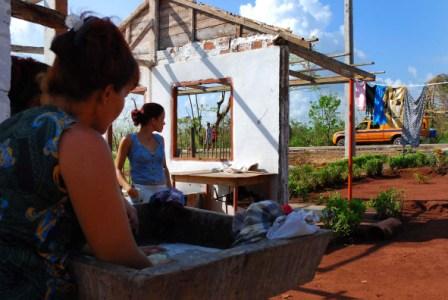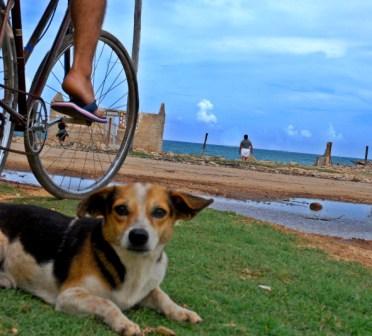Cuba Strategizes to Face Hurricanes

HAVANA TIMES, August 1 – Hurricanes come and go in Cuba but the aftermath is felt for a long time – sometimes several years. When a storm is approaching, Cuban TV and radio bombard the public with information on evacuations and other types of home, workplace and community preparations.
When the storm finally hits the island, even in the most affected areas people receive around-the-clock news amid hurricane winds and rains.
As a foreigner I can attest to the extreme measures taken to guard human and animal life and to protect private and public property.
When three major hurricanes (Gustav, Ike and Paloma) pounded the island in the second semester of 2008, one of the biggest effects was felt on the dining room table, as the island’s agriculture was devastated.
With hurricane season running from June 1 to November 30, the following is an IPS report addressing what can be done to reduce the impact of natural disasters on the Cuban people’s diet.
Best Practices in Reducing Disasters in Cuba
There are approaches to disaster management that should be improved and shared throughout the Caribbean. The exchange should take place at the various levels of the organizational infrastructure of agricultural and forestry, scientific and educational institutions in the region.
The report “Lessons Learned and Consolidation of Best Practices in Agriculture for the Reduction of Disasters Caused by Hurricanes and Other Hydro-Meteorological Phenomena in Cuba,” produced by that country’s Ministry of Agriculture in November 2007, amasses the most effective strategies for facing extreme climatic situations, which in the case of Cuba are hurricanes, drought, tornados, severe electric storms, sea flooding, hail and forest fires.
To protect soil from erosion due to intense rain and wind, for example, it is necessary for land to be cultivated. The wearing away of soil is greater when the land is barren since there are no restraints. Agro-forestry systems have proven to be the most appropriate because they integrate techniques for land management based on the combination of agricultural, livestock and forestry production.
As a long-term solution, the land should be covered by living species that adapt to it; alternately, quick-growing or dual purpose coverage can be employed to mitigate the impact of downward flows of rainwater. These technologies can be combined with fixed barriers, such as the construction of terraces containing stones to prevent soil from washing away.
Maintaining staggered plantings and crops with different harvesting periods (short-cycle crops as well as longer-term ones) are ideal for the beginning of a cyclone season.
In areas hit less often by extreme climatic events, a variety of crops should be farmed. In the event of a climatic anomaly, a priority should be placed on preserving seedlings, moving them to safe places, as well as to protect botanical seeds and plants such as sweet potato vines.
In the case of cattle farms, whenever a hurricane is announced in the vicinity, animals that are at risk should be moved to higher ground, in addition to better protecting the roofs of barns. Young cows and calves should be taken to appropriate facilities covered with polyethylene blankets; likewise, they should be supplied bales of hay or silage, water, and medication for the time when they will be subjected to difficult conditions, such as extreme dampness that fosters the transmission of disease.
To conserve milk when a hurricane occurs and there are no possibilities for refrigeration or timely pick-up by processing industries, a natural preservative known as Stabilak is used that extends the life of this food after milking. Stabilak was created by Cuba’s National Center of Agricultural Health and is used across almost the entire country.

Another of the measures announced by the Ministry of Agriculture is the construction of micro-reservoirs, holding ponds and wells to reduce flooding; in addition, these allow for the storage of water for animals and irrigation. Also recommended is the installation of groups of electric generators for maintaining water distribution, and measures to protect veterinary medicines and cover feed in large scale production units.
In the case of the pork livestock, it is necessary to maintain systematic control over bio-security through perimeter fences and ditches, and the disinfecting of equipment and personal, in addition to protecting installations and roofs of breeding, reproduction and fattening facilities.
Wind and rain constitute the main forces that harm honey production when the ecosystems that serve to support the feeding of bees in beehives are destroyed.
When confronted with climatic disaster situations, beehives can be provided with sugar flavored foods to stimulate the continued laying of eggs by the queen until the period of flowering period returns. It is important that in the surroundings of the apiary (hives) there are planted melliferous (honey producing) plants, such as flowering pine nut, mangos, avocados, mahogany, cedar and oak.
In the 2008 hurricane season, the beekeeping industry suffered the loss of 9,000 bee colonies, which were demolished by the force of the wind, falling trees, floods, and other causes. Another 30,000 colonies suffered other various forms of damage.
Damage caused by hurricanes Gustav and Ike in 2008
Soil damage
– Emergence of new ravines and the deepening of small, medium and large chasms in the earth.
– Hydro-regulators, at the edges of river and reservoirs, were damaged.
– Areas benefiting from soil conservation measures were harmed.
– There was a loss of organic fertilizers and worm breeding facilities.
Poultry:
– Losses of hens and eggs, breeding facilities, warehouses, roads, administrative areas, etc.
– Serious deterioration of the bio-security, with the direct exposure to the elements of more than 800,000 birds – of these, 550,000 were egg-laying hens and 250,000 early-age replacement fowl.
– High loss of animals by death and sacrificing for public health reasons.
– Collapse and destruction of facilities, with a reduction in the capacity of the breeding of birds of all categories and production purposes.
– Breakdowns in electricity networks, hydraulic systems, breeding equipment, fences and other sanitary barriers; damage and deterioration of egg production that caused direct and unrecoverable losses in the organization of the poultry economy.
– Damage in the movement of flocks and disruption of the technological process.
– The onset of illnesses, primarily respiratory and intestinal ones.
Various crops
– More than 113,630 hectares of numerous crops were laid waste, among those that stood out were:
- 53,280 hectares of bananas
- 21,988 hectares of yucca
- 8,202 hectares of vegetables
- 15,600 hectares of various grains
Citric and fruit-bearing
– Some 100,000 citric and 2,000 fruit-bearing seedling suffered partial damage.
– 47,802 tons of grapefruit, 12,000 tons of oranges and 47 tons of Persian lime were lost due to falling fruit.
– 280 tons of coconuts could not be processed in that industry.
– 205 of the 1,950 protected cultivation houses in existence were damaged.
– Some 60 irrigation machines met with various types of damage.
Livestock
– 2,548 cattle facilities were partially affected.
– 1,903 heads of cattle died.
– 24,924 animals were evacuated.
– More than 1.82 million liters of milk spoiled and 3 million of liters of milk could not be collected due to the poor weather conditions.
Pork
– About 110,000 hogs suffered different types of injuries from falling roofs and intense rains.
– 1,500 heads of breeding stock died or were sacrificed.
– 10,000 dead or affected breeds.
– 15,000 animals sacrificed.
Tobacco
– 9,794 tobacco curing houses were damaged, of which 4,900 were destroyed and the rest affected (of that total, more than 7,150 were in western Pinar del Río Province).
– 131 tobacco drying facilities damaged and 89 destroyed
– 131 selection facilities destroyed and 90 affected.
– 1,526 tons of tobacco was left rain-soaked and 197 were lost.
A Havana Times translation of an IPS original in Spanish





